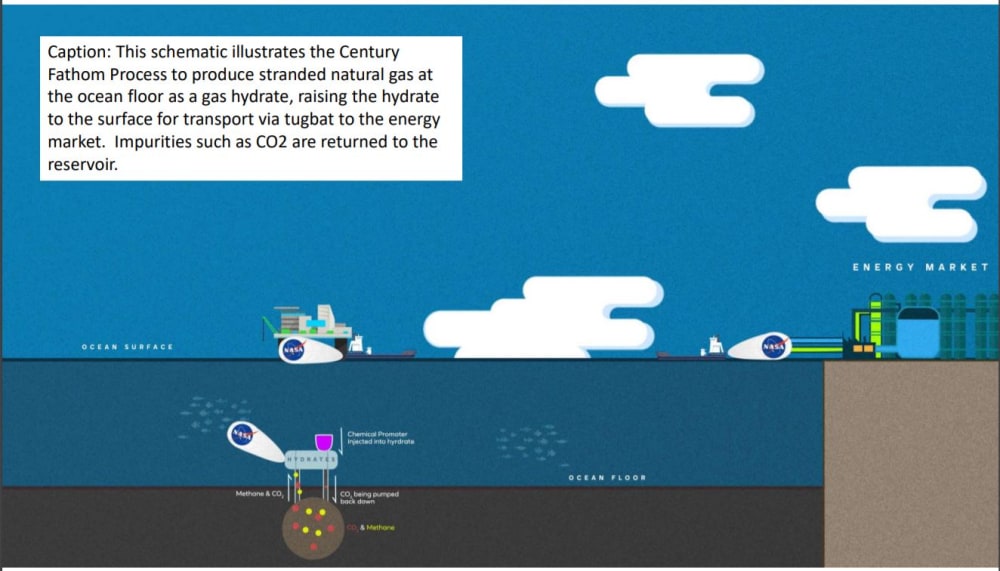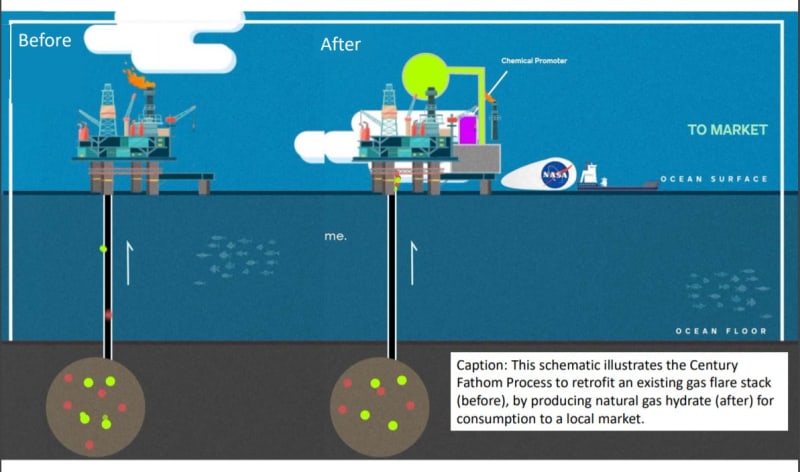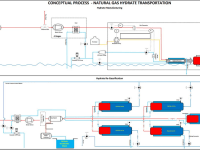
Century Fathom presents a novel method using Natural Gas Clathrate Hydrates (NGH) for producing natural gas from sub-sea petroleum reserves. Our patented process enables production of reserves which are deemed stranded either because they contain a high content (percentage) of impurities, specifically carbon dioxide and/or sulfur, or because production capacity (quantity) is too small to implement conventional methods, particularly Liquified Natural Gas (LNG). The Century Fathom method is less than half the cost of these existing methods.
In a typical offshore platform, natural gas is processed by 1) introducing hydrate inhibitors, needed to maintain flow assurance, 2) pumped to the surface, 3) cooled down to -163⁰C to condense the gas, expending 10% of the resource to form LNG and 4) stored locally for transfer to a specially-designed carrier for shipping around the globe. Generally, these ships then return to the platform for the next load.
Recognizing that hydrates form rapidly and vigorously at the sea floor, Century Fathom exploits this phenomenon to transform subsea natural gas at the ocean floor to an artificial natural gas hydrate. NASA pressure vessel expertise has been utilized to design a vessel with features of strength, flexibility, and neutral buoyancy to enable this operational concept. Filled storage containers are subsequently raised to the ocean surface. The Century Fathom hydrate containers float so they can be tugged to the destination market, at less cost and energy consumption than traditional cargo ships or LNG carriers.
Recent advances, notably at the National University of Singapore (Linga Lab), have shown that the introduction of a chemical promoter further enhances the kinetic rate of formation and reduces the requirements on temperature and pressure, expanding the potential locations for production in more shallow ocean depths.
With the promoter, the conditions can be better controlled to a form a gas hydrate and exclude impurities (CO2) due to kinetic rate and thermodynamic constraints. These impurities can be sequestered in the original reserve location. High CO2 fields are no longer deemed stranded because of this method. The use of a promoter reduces the requirements on temperature and pressure and enables the retrofitting of existing gas flare stacks to capture the methane. The natural gas realized from currently flare stacks are carbon negative.
When hydrates are dissociated, the products are water and natural gas, both of which have been separated from impurities. If ocean water is used as the carrier liquid, experiments have shown more than 85% of the inherent salts are removed. If the system incorporates associated water then the Century Fathom process eliminates the expense of water disposal while recycling it for subsequent use. Natural Gas Hydrates can serve small markets who cannot access LNG and must currently rely on diesel,. Typically, these markets also need potable water.
The proposed system presents an inherently safer system than conventional methods. Hazards associated with handling of compressed or cryogenic fluids are eliminated by design. The platform to carrier is particularly risky. The sub-sea process is managed autonomously and avoids hazards associated with adverse weather conditions.
Video
-
Awards
-
 2020 Top 100 Entries
2020 Top 100 Entries
Like this entry?
-
About the Entrant
- Name:Michael Kezirian
- Type of entry:individual
- Patent status:patented








